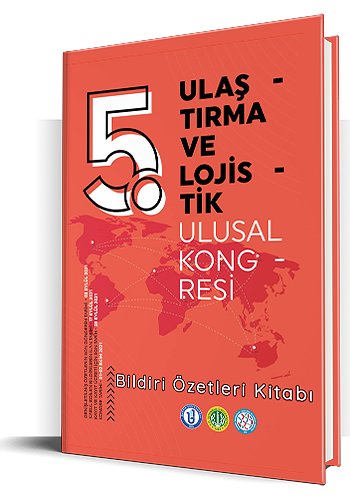
Ulaştırma ve Lojistik Kongreleri
- Türkçe
- Özet
- 2021
Lojistik Köy Seçimi İçin AHP-TOPSIS Temelli Bir Karar Verme Yaklaşımı
Sezin Güleryüz
Dr. Öğr. Üyesi, Bartın Üniversitesi, Bartın, Türkiye
Şebnem Çoşmuş
Bartın Üniversitesi, Bartın, Türkiye
Anahtar Kelimeler: TOPSIS, Çok Kriterli Karar Verme, Lojistik Köy, Lojistik Yönetimi, AHP
A Decision-Making Approach Based on AHP-TOPSIS for Logistics Village Selection
The importance of the logistics sector has increased more with the increase in the interaction between the countries and the effect of the commercial activities developing accordingly. With the economic developments experienced today, where production and consumption are increasing rapidly, a tough competition has started and intercontinental trade has gained speed in every corner of the world. With the disappearance of borders today, effective use of time and minimization of costs in international trade are at the forefront. There are all kinds of businesses and institutions, large and small, that play a role in the rapid developments in trade and, accordingly, world trade. These institutions and businesses had to find new ways and solutions to keep up with the increasing costs, developing technologies and the demands of corporate and individual customers who purchased the product in order to stay in free market conditions. Due to these needs, logistics villages, which are now widely used in the world, have emerged. In the Turkey Logistics Master Plan (TLMP) Executive Summary 2019, the concepts of logistics center, freight village, logistics base, logistics specialized organized industrial zone are defined as synonyms for logistics villages. The main purpose of establishment of logistics villages; storage, maintenance-repair, loading-unloading, handling, weighing, dividing, combining, packaging etc. to carry out its activities and to make low-cost, fast and safe transfers between transportation modes. With the most general definition, logistics village; It refers to the realization of many integrated logistics activities such as transportation, distribution, storage, handling, consolidation, separation, customs clearance, export, import and transit transactions, infrastructure services, insurance and banking, consultancy and production within the same region. In addition to logistics-related activities and storage services within the logistics villages, it has infrastructure, various facilities, and equipment that provides social and technical support. Diversity of transportation networks and easy access to these networks are important for transportation and processing of goods within logistics villages. With the establishment of logistics villages, it provides a decrease in transportation, industrial and personnel costs thanks to the optimizations to be made in the use of storage, workforce planning, and logistics chain. This decrease will cause an increase in business volume and prevent environmental and traffic problems and pollution. The logistics village gave its first example in the world with its emergence as a result of the developments in the industry in the USA. Logistics village applications started to spread first to Japan and then to Western European countries after the USA. The first logistics village established in Europe is Sogaris Logistics Village in France. Then, in the 1960s and 70s, examples became operational in Italy and Germany. In the 1980s and 90s, logistics villages began to be created all over the world with a rapid increase. Due to its geographical location, Turkey is in a transitional position between the eastern and western worlds. In addition to its highway and railway connections, it is in a peninsula position surrounded by seas on three sides, making it the center of Eurasian trade with its airport and distribution centers. It is at the connection center of Central Asia, Black Sea, Europe, Middle East, Balkans, Caucasus and North African countries. Despite being in such an important location, logistics villages came to Turkey in the early 2000s, long after they were used in the world. The first logistics village of Turkey is samsun Gelemen logistics village, the construction of which was started in 2006 and the first phase was opened for use in 2007. By 2021, there are a total of 27 logistics villages in Turkey, 11 of which are open for operation and 16 of them are under project, plan and construction. Due to the long-term and high cost of logistics village projects, the widely used business model is widely preferred as a public-private partnership. The management of the logistics villages established in Ankara and Manisa, out of a total of 27 logistics villages that have been put into operation in Turkey and are at the plan-project stage, is carried out by the private sector. The operation of the remaining 25 logistics villages belongs to the public sector or public-private cooperation. The aim of this study is to compare the results of Filyos (Zonguldak), Iyidere (Rize) and Çandarlı (İzmir) logistics villages, which are in the planning stage, by using TOPSIS and AHP methods and to evaluate them in order of advantage. The originality of the research is due to the fact that the method, which is frequently used in the literature, is applied with a real case study that includes alternatives that are still in the project stage. The main criteria used in the study; qualified workforce, transportation infrastructure, economy and development. Sub-criteria of the main criterion of qualified workforce; qualified workforce, the number of high school graduates and the number of college employees. Sub-criteria used for transportation infrastructure; land, sea, air and rail transportation. Sub-criteria of economy sub-criterion; foreign trade income, distance from border gates and leading sector. Sub-criteria of the main criterion of development; life index, development region and unemployment rate. As a result, all main criteria and sub-criteria gave consistent results in the AHP analysis. According to the ranking made by TOPSIS analysis, Filyos logistics village took the first place, followed by Çandarlı and İyidere logistics villages, respectively. Filyos Logistics Village, which ranked first in the evaluation phase, is targeted to be Turkey's first mega-industrial region within the scope of the Filyos Valley Project. Filyos Free Zone is 1,166 hectares in size. Two large thermal power plants established in the region and located 15 km from Filyos Valley have an installed power of 3,100 MW. Within a radius of 100 km from the center of Filyos Valley, there are Erdemir and Kardemir, Turkey's largest integrated flat and long product iron and steel producers. Filyos Valley basin has multi-modal transportation opportunity, including road-air-railway and port. Çandarlı, which follows Filyos logistics village with a very close score, is a logistics village planned to be established in Soma. It is planned to use Çandarlı port for maritime transport, with Soma as its main centre. Likewise, it is planned to use İzmir province for air transport. With the opening of the Ovit Tunnel, which ranks 3rd in the Iyidere logistics village, the advantage and ease of use of Rize Iyidere Logistics Port has increased. In the region where there is no railway line, the closest airport used for air transportation is Trabzon airport. As a result of the AHP and TOPSIS analyzes, the factor affecting the finding of Filyos logistics village as the most suitable logistics village is that it is probable approriate for multi-modal transportation. The fact that it has access to highway, seaway, airway and railway networks within the same area has been an important factor in its ranking in the first place, unlike other logistics villages evaluated.
Keywords: Multi Criteria Decision Making, AHP, Logistics Management, TOPSIS, Logistics village


Bu çalışma, kullanan kişilere orjinal çalışmadan alıntı yaptıkları sürece, çalışmayı dağıtma, değiştirme ve üzerine çalışma hakkı tanıyan Attribution 4.0 International (CC BY 4.0) lisansı ile lisanslanmıştır.
İletişim
İstanbul Üniversitesi Ulaştırma ve Lojistik Fakültesi
İ.Ü. Avcılar Kampüsü 34320 Avcılar/İstanbul
ulk@istanbul.edu.tr
+ 90 (212) 440 00 00 - 19200


